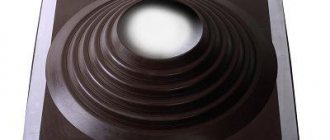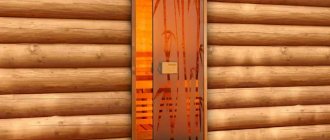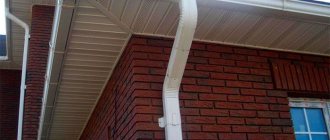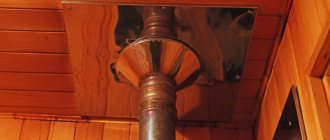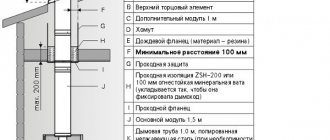Profiled sheets are used for arranging the roofs of residential buildings, cottages, bathhouses, garages and many other types of buildings and structures. The material is distinguished by its presentable appearance, strength, durability, and is easy to install with your own hands. Craftsmen have to face the problem of sealing chimney passages through the flooring. An effective solution to this issue is to install master flash on metal tiles. This device is also excellent for coatings such as ondulin and slate.
What is Master Flush
Master Flash ensures the sealing of the pipe.
The Master Flash penetration is a two-component product made of sheet metal and an elastic truncated cone. The base is an aluminum plate with a side of up to 80 cm. The top is made in the form of a straight pyramid with protrusions in height. The connection of the parts is made by soldering and is absolutely sealed.
The principle of operation of the Master Flash penetration is to simultaneously press the flexible part against the pipe, and the rigid part against the roof surface. The remaining cracks are sealed with a sealant, and the metal itself is tightly screwed to the flooring.
About the conditions of use
An elastic rubber penetration would be an excellent option for ensuring reliable waterproofing in the chimney passage area. But it will not be appropriate in all cases. Experienced experts say that such a device is suitable for equipping the following smoke exhaust channels:
- Sandwich chimneys. These pipes have two contours made of durable galvanized steel, between which there is a layer of thermal insulation, most often represented by basalt fiber. This material retains heat through the inner pipe, which is why the outer part of the chimney does not warm up much, remaining practically cold. Optimal waterproofing of sandwich pipes - rubber models.
- Stainless steel chimneys, through which combustion products are discharged into the external environment when heating premises, are distinguished by the fact that they heat up very much. It is customary to fill the gaps between them and the roofing surface with heat-resistant penetrations made of silicone. In this case, master flush rubber models are also suitable, but if the chimney is powered by a gas condensing boiler.
Advantages and disadvantages
The products have the following advantages:
- Tightness. The materials used are flexible and resilient. Provides tight pressure to the pipe and flooring of any configuration.
- Elasticity. The products are suitable for slopes of any steepness, surface relief and material of protruding fragments.
- Strength. All components of the penetration correspond to the resistance to mechanical loads of the roof covering.
- Versatility. Parts can be equally successfully installed on smooth, wavy and profile coatings with all types of patterns. The scope of application is simply unlimited.
- Durability. The materials used in production are resistant to ultraviolet radiation, abrasives, and chemical reagents.
- Easy and quick installation. The whole procedure takes no more than 15 minutes in summer and an hour in winter, when it is necessary to clear the work area of snow. Detailed instructions for the product help you do everything accurately and accurately.
- Quite affordable cost, similar to the cost of the kits that were used before.
When the temperature rises to a critical level, the flexible cone lights up. This imposes certain restrictions on the scope of use of the products.
Equipment
The sealing product consists of the following elements:
- A flexible cuff, which is a truncated rubber cone. The cone is usually made of silicone or ethylene propylene materials. The cuff serves to connect the pipe to the roof deck. In the upper area, the cone fits tightly to the chimney pipe, and in the lower area it is connected to the base of the sealing structure;
- The flange serves as the base of the structure and is made of the same materials as the cone. Can also be made of galvanized steel or aluminum. The base of the flanges has special aluminum strips for mounting on the deck. This gives the structure the tightest possible fastening.
For a pitched roof, special penetrations with cuffs located at a certain angle to the flanges are purchased. On the cone of such a device, corrugations with gradations in diameter are clearly visible. Such corrugations help change the slope of the penetration in the required direction.
Varieties and Selection of Master Flash
Products of domestic and foreign production go on sale. Seals are distinguished according to the material used to make the flexible and rigid parts.
Cones are made from the following polymers:
- Rubber. Ethylene propylene rubber, which belongs to the class of synthetic elastomers, has high elasticity, flexibility, and a high degree of moisture protection. The EDPM standard material has a porous structure, low thermal conductivity, and immunity to fats and mineral oils. Such penetrations can be mounted on structures whose temperature does not exceed 100 degrees.
- Silicone. These seals are designed for higher temperatures and have a heating limit of 240 degrees. As it increases further, the material melts but does not burn. Ultraviolet intolerance can be considered a minus. With intense solar radiation, silicone hardens over time, cracks and loses its seal.
The plates are made of galvanized iron, stainless steel and aluminum. The pricing policy for each metal is different, but the performance indicators are also higher depending on the price.
Elastic nozzles are available in straight and inclined versions. The standard is 90, 30 and 45 degrees. At the same time, the pyramids are flexible and elastic enough to easily close pipes with a deviation of up to 20 degrees from the declared value.
At each level of the pyramid there is an inscription about the corresponding internal diameter. The technician just has to measure the size of the canal and cut off the excess with ordinary scissors. It must be taken into account that the cross-section of the lining should be 20-25% smaller to ensure a tight and airtight connection.
Sealant and self-tapping screws are included with the penetration. It is necessary to use components that are resistant to environmental influences. Since the plate will still be painted over, the color does not matter. A silicone washer and a drill before threading screws are required.
Recommendations
- For flat roofs, any “master flush” with a wide, compacted base will do. But for corrugated sheeting, it is always better to choose something more flexible, with reinforcing elements around the perimeter of the fold due to the high edges of the sheet. A dense base will be more difficult to bend and therefore more difficult to ensure a seal.
- For roofs with a slope of 45 degrees, a roof with a round or square flange is suitable. For roofs with a slope of 60 degrees, it is recommended to choose penetrations with an elastic base that are much larger in area for better installation.
- If there is no corner “master flush” on sale that corresponds to the angle of inclination of the roof slope, then you can purchase a straight one, but with a larger base area. Due to the flexibility of the material and the corrugation of the cone, the tilt will be invisible.
General installation principles
To install the penetration, you will need a very small set of tools that every owner has:
- screwdriver;
- mallet;
- glue gun;
- self-tapping screws;
- sealant;
- marker;
- knife or scissors.
Since you will have to work at heights, while also being on an inclined surface, you need to think carefully about safety issues. Reliable insurance, a helmet, goggles and gloves are required. Fencing and warning signs should be placed below.
Installation of master flash on corrugated sheets:
- Try the plate on the roof. Draw its outline with a marker, taking 5-10 cm more in each direction.
- Prepare the surgical field. Remove debris, snow from the corrugated sheet covering, clean the surface from moss, mold, rust, and other foreign substances.
- Carry out a similar procedure with the exhaust duct. There should be no protruding parts on it. If there are sharp edges, they must be bent, cut off or ground off.
- Carry out control measurements. Mark the cut location on the pyramid. Once again, make sure that the calculation is correct and remove excess silicone.
- Remove the shipping film from the penetration. Clean the product from dust and crumbs.
- Lubricate the pipe with soapy water. Carefully place the cap on its head and slowly lower it with scrolling to the level of the coating. Press down the pyramid so that the plate presses on the flooring.
- Raise the base and install it in this position at a height of 40-50 cm from the surface.
- Apply a continuous layer of sealant inside the marked contour. Check that it is evenly distributed over the entire area.
- Place the plate in the lower position. If possible, insert its upper edge under the cladding. Starting from the center, press it into the hollows of the coating. If the metal gives in poorly, use a mallet.
- At intervals of 10 cm, attach the plate to the roofing material. Tighten tightly, but not so tightly that the sealant squeezes out from under it.
- Paint the penetration to match the color of the roof.
If the work is done correctly, the penetration will serve properly for at least 15 years, and its subsequent replacement will not cause much trouble.
Algorithm of actions for the device
The chimney is installed and fixed in the base area.
During the construction of the canopy, it will be necessary to dismantle the pipe canopy, if it was already attached to it.
Next, perform the following steps:
- The size of the ring on the penetration is determined. It should be 20 percent less than the diameter of the chimney. Using a sharp knife, cut to the desired size. If the gap is unsuccessfully cut, do not rush to throw away the Master. You should try to correct such a flaw using a tightly installed clamp;
- The prepared Master pulls himself onto the pipe and with force lowers himself to the roof level. To make sliding easier, you can use soapy water as a lubricant;
- In the case of making a roof covering from ondulin, tiles, slate and other covering materials laid overlapping, the upper section of the base of the otter must be moved under the adjacent, outermost component of the insulation. This will create conditions for free drainage of water regardless of sealing;
- A moisture-resistant sealant or bitumen is applied under the base, and the flange is secured with self-tapping screws with a large press cap to the roof and sheathing. The distance between the screws should be maintained at 3.5 cm.
Expert advice: you should not screw in a large number of screws, since over time the sealant will gradually begin to lose its insulating qualities, and moisture will begin to enter through multiple punctures from the screws.
It is not recommended to screw self-tapping screws into depressions in the roofing material through which water flows. The flexible, sealing element can be easily bent to fit the roof profile and attached with minimal gaps. This completes the installation process.
In rare cases, a tight fit of the roof to the pipe is not observed. In this situation, the edges of the seal should be tightened with a clamp. This state of affairs serves as proof that the Master Flush was not selected accurately or the installation was carried out with errors.
Such auxiliary parts can be easily completed and installed with your own hands, or can be purchased at specialized construction stores. Such a “plate” is simply strung on the chimney on top of the otter. The size of the metal pad must be accurately selected to prevent it from oscillating due to wind.
The maximum operating temperature of Master Flash shows that the gasket cannot be used on every chimney. The otter will behave well if the chimney is insulated with a sandwich or on a chimney without insulation, which will heat up to no more than 100 degrees.
Expert recommendation: to avoid unpleasant situations - ignition or melting of the “master” during soot burning in an uninsulated pipe (temperature can reach 500-600 degrees), it is necessary to first perform thermal insulation work on the chimney.
For this purpose, basalt fiber is used, which is coated with galvanization.
According to numerous reviews, the widespread use of Master Flash roof seals is due to the convenience and speed of installation. Important advantageous factors are the affordable price, reliability of insulation, and long service life.
And there is no point in attracting highly qualified specialists or additional workers, since the instructions for the seals clearly and clearly describe the installation process, which any layman can handle.
Watch the video in which the master explains how to properly install and secure Master Flash for a chimney:
What harm can foam plastic cause when used for exterior decoration?
The use of polystyrene foam is considered absolutely safe for humans, since even the small amount of harmful substances that can be released from this material completely dissolves in the air upon contact with warm air or moisture.
However, in this case, a very important point is the correct installation of the material. After attaching the foam plastic, it must be plastered or covered with other finishing material in order to protect the material from ultraviolet rays and heating in the summer, as this can provoke an increase in the amount of harmful substances released into the air.
Why is it needed?
Master flush is a universal type of sealant for effectively insulating roof penetrations. The device can be used for all types and coverings of roofs. Well suited for roofs made of metal tiles, corrugated sheets and tin. Installation of the penetration can be carried out both on a roof with a metal deck, and on a soft roof, sand-cement or slate.
An important advantage of the device is its resistance to temperature changes and exposure to sunlight. Therefore, installation of the penetration can be carried out at any time of the year and at any temperature.
- Flexibility. With the help of a sealant it is easy to create a tight fit to the chimney;
- Heat and frost resistance;
- Not susceptible to oxidation;
- High strength of the material;
- High level of sealing against water ingress;
- Resistance to deformation;
- Long warranty period up to 30 years;
- Easy to install;
- Savings on additional waterproofing work around the device.
Estimated cost
The cost of a master flush depends on what material it is made of. If the base is silicone, then such materials are more expensive than those based on rubber.
Prices for silicone wings range from 1,500 rubles to 3,500 rubles per piece. The price depends on the diameter and the size of the material.
Prices for rubber roofs range on average from 255 rubles to 600 rubles per month.
That's all! As you can see, master flush is an inexpensive material. It should be remembered that if everything is done in accordance with the rules, the gap will be closed hermetically, which will further prevent water from entering under the roof.
Also, when working at height, one should not forget about safety rules.
The “Master Flash” protective device is designed to seal joints and prevent moisture from entering; such penetrations are mounted around the chimney pipe and can withstand temperatures of about 300 degrees. The product is endowed with quite good indicators of flexibility and heat resistance, as well as excellent elasticity.
The “Master Flash” protective device is designed to seal joints and prevent moisture from entering; such penetrations are mounted around the chimney pipe and can withstand temperatures of about 300 degrees. The product is endowed with quite good indicators of flexibility and heat resistance, as well as excellent elasticity. The roofing protective element “Master Flash”, due to its technical data, expands when heated and contracts when cooled. The protective penetration has sufficient strength and has a long service life. The penetration is not susceptible to bright sunlight, and is not destroyed by strong winds and various atmospheric precipitations. The Master Flash protective product can be very easily installed at the junction of the chimney pipe and the roofing material. After Master Flash protective products went on sale on our domestic market, the owners of private houses resolved all the problems associated with sealing the roof area around the chimney duct.
Necessary materials
Before installing the master flush on the roof, check its contents. You will need:
— Master flush for a pipe of the appropriate diameter. When choosing, also focus on the temperature of the exhaust gases, since the choice of material from which the roof is made depends on it.
Advice! When choosing a penetration, keep in mind that a flash master with a reinforced base has a longer service life, but provides insufficient adhesion when installed on metal tiles, corrugated sheets or other embossed roofing materials.
— A plate used to protect the wing from sunlight. It can be purchased at building materials stores or made with your own hands. It looks like an ordinary plate without a bottom.
— Screwdriver, self-tapping screws, metal scissors and heat-resistant silicone sealant
Expert advice
The construction of a proper chimney system is the basis for the efficient and safe operation of heating equipment. If you plan to assemble it yourself, then advice from masters - professionals in this field - will not be superfluous.
Subtleties of switching from a brick pipe to a sandwich
At the point of transition from a brick pipe to a sandwich, it is better to install not a homemade, but a ready-made metal adapter. Its lower part corresponds in size to a brick channel, and the upper part has a round shape with a diameter equal to the diameter of the sandwich. A reliable heat insulator is already installed inside. The use of this device ensures the necessary tightness and fire safety of the connection.
Subtleties of passing through a wooden roof
When using ready-made polyurethane foam, it is necessary to take into account that wood can expand at high humidity, so there should be a small gap between the walls of this device and the opening, approximately 3 - 5 mm. In addition, it is important to impregnate the wood in the joint area with anti-friction agents, which increase its fire resistance.
Where is the best place on the roof to install the pipe?
It is better to move the place where the pipe exits through the roof slightly from the ridge to one side. If it passes through the ridge, then when installing the passage unit, it will be necessary to violate the integrity of the rafters and the ridge beam.
Structural properties of the seal
Roof seals are replacing pipe flashings that have been used for several decades. In design, these two products are little different, but modern devices consist of two main parts:
- Flexible cuff. It looks like a truncated rubber or silicone cone with markings. The cuff provides a tight seal between the pipe and the roof, preventing moisture and dust from penetrating inside. After installation, the upper part of the cone tightly closes the sandwich chimney. The lower part of the system is connected to the flange.
- Flange. It looks like a round or square skirt. The raw materials for its production are rubber, silicone, lead, aluminum or galvanized sheet. When installed on a roof with large embossed corrugations, the silicone or rubber base is equipped with aluminum strips around the perimeter. This allows the flange to fit as tightly as possible to the surface.
On pitched roofs, the seal cuffs are placed at an angle to the base. Corrugations increase the accuracy of pipe cutting. This allows you to change the angle of inclination of the seal according to the manufacturer’s parameters.
You can distinguish Master Flash for installation on flat roofs by the location of the imaginary central axis of the cone. To do this, it is mentally drawn strictly perpendicular to the surface of the base.
